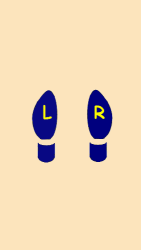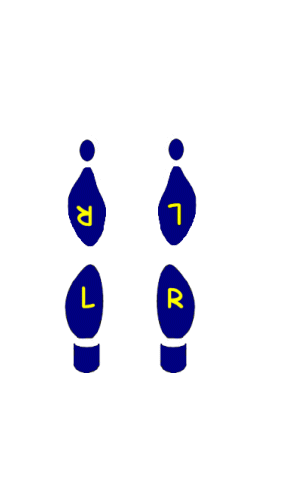There are many styles of salsa dance. They can differ in many ways. Some of the ways in which they may differ are very nuanced. However, there are two primary defining characteristics:
- The traveling style
- The timing used for the break step in the basic step
The break step determines when to change directions in the basic step.
Break Step: A two step sequence in which the second step is in the opposite direction as the first.
In On1 timing, Leader will break forwards on beat one, and break backwards on beat five. Follower does the opposite, breaking back on beat one and forwards on beat five.
On1 LA Style Basic Step:
On1 basic step: Uses 8 beats to complete; with the feet alternating step on beats 1,2,3; pause on beat 4; stepping on beats 5,6,7; pausing on beat 8
Los Angeles Style is often referred to as LA Style and also as West Coast Style. LA style salsa is an eight beat dance made up of six steps and two pauses. The eight beats cover two musical bars. It is an “On1” style because its break step is on the first beat of the musical bar. Steps 4 and 8 are paused.
A common way of counting the steps over two musical bars is “1-2-3, 5-6-7”. Another common way of counting the steps is to recite "quick quick slow, quick quick slow", with each quick taking one beat, and each slow taking two beats. The following animation illustrates the On1 Basic Step for the Leader.
On1 Basic Step:

The following animation illustrates the On1 Basic Step for the Leader and Follower, from the perspective of Leader.
On1 Basic Step for Leader and Follower facing each other:

Some styles have their break step on the second beat of the musical bar. For this reason, many refer to such styles as “On2”. In On2 timing, Leader is breaking on beats two and six.
On2 basic step: Uses 8 beats to complete but breaking on beat two of the musical bar, equivalently on beats two and six of the eight beat count. This can be done in several ways.
Several styles utilize On2 timing, including New York Style, Mambo On2, Eddie Torres Style, Mambo Palladium Style, Classic Mambo, and Son Cubano.
How the step is counted can vary within the On2 styles. The Palladium style basic step counts its steps as "2-3-4, 6-7-8". One can also count the steps by reciting "quick quick slow, quick quick slow", with the first quick on beat two, and a slow step on beats 4&5, and on beats 8&1. It is like On1, but delayed a beat.
Even though Eddie Torres style uses On2 timing, it counts its steps as "1-2-3, 5-6-7", just like the classic On1 style illustrated above. If counting the steps by reciting "quick quick slow, quick quick slow", then the first quick occurs when the leader's right foot returns to center on beat one, with a slow step on beats 3&4 and on beats 7&8.
Another defining characteristic of a style of salsa dance is whether the dancers tend to travel along a line or circle around each other. Traveling along a line is known as “in the slot”. LA Style and New York style are “in the slot”, and are also referred to as “crossbody” styles.
On1, In the Slot:
In a circular style, the dancers revolve around each other. A workable analogy is to compare crossbody styles with West Coast Swing, whereas circular styles are akin to East Coast Swing. Cuban Style is a circular style, as is Casino Rueda Style.
Circular:
Yet other styles!
Though many of the core elements are common among styles of salsa dance, styles use their own terminology for many terms. Know that salsa dance is regional. Having a vocabulary and an eye for the component building blocks will help understand other styles. That said, be forewarned that other styles and even regions that appear similar may use a different vocabulary.
We covered just a few of the many styles of salsa dance. There are others not mentioned above, including Puerto Rican Style, Colombian Style, Cali Style, Miami Style, Cuban Style, and Ballroom Style Salsa.
More Reading
To learn more about salsa dance check out these books:
-
Illustrated Handbook of Salsa Dance: Positions
-
Illustrated Handbook of Salsa Dance: Patterns
-
Illustrated Handbook of Salsa Dance: Butterfly Patterns